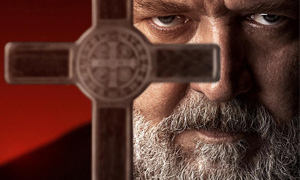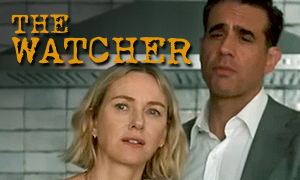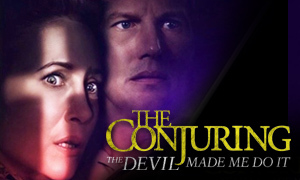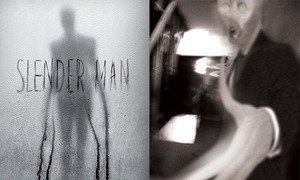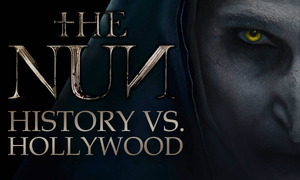The Pope's Exorcist: History vs. Hollywood
Russell Crowe
Born: April 7, 1964
Birthplace:
Wellington, New Zealand
Father Gabriele Amorth
Born: May 1, 1925
Birthplace: Modena, Emilia, Kingdom of Italy
Death: September 16, 2016, Rome, Italy (pulmonary-related illness)
Is The Pope's Exorcist based on a true story?
Not exactly. While it was inspired by a real person and his work as an exorcist, the movie doesn't depict any specific cases that the real Father Gabriele Amorth focused on. Instead, the filmmakers took bits and pieces from Father Amorth's notes and memoirs and used them to inspire the entirely fictional storyline around which the movie unfolds. In this way, it is similar to the films in The Conjuring series, especially some of the spin-offs that followed the 2013 horror hit. That's not to say The Pope's Exorcist doesn't reference a few actual historical events, as we'll detail below, but even the way it describes those events is significantly fictionalized to fit the movie's narrative.
What is an exorcism?
In Father Gabriele Amorth's own words, "An exorcism is a prayer said in Jesus' name to cast out demons. And so it is the strength of the name of Jesus which gives the power to cast out demons." An exorcist is most commonly a Catholic priest who has been authorized by their bishop to perform the rite of exorcism. These individuals diagnose and treat cases of demonic possession and other types of demonic influence.
How many exorcisms did Father Gabriele Amorth perform?
While conducting The Pope's Exorcist fact check, we learned that Father Gabriele Amorth claimed to have performed more than 70,000 exorcisms. He carried out many of these exorcisms on the same individuals, as it almost always requires multiple exorcisms to cast out a demon. A person can also be possessed more than once.
Is the emergency "exorcism" that Gabriele performs at the beginning of the movie based on a real account?
At the beginning of The Pope's Exorcist, Father Gabriele Amorth (Russell Crowe) is called to the village of Tropea, Italy by a terrified priest to perform an emergency exorcism on a possessed man. After encountering the man, Father Amorth suspects that he is not actually possessed. Amorth challenges the alleged demon in the man to possess a pig they brought inside. Pretending that the demon has entered the animal, the pig is shot in the head. Father Amorth comforts the recovering man and assures him that God is with him. By duping the man, he proved that the man's affliction was psychological.
In researching The Pope's Exorcist true story, we discovered that the case was most likely inspired by the case of Roberto in Gabriele Amorth's memoirs. As the fictional Father Amorth states in the movie, the majority of cases of possession he encountered were actually cases of mental illness in the form of psychosis or personality disorders. Therefore, such cases were not uncommon.
Are most cases of possession imagined?
Yes. The Father Gabriele Amorth movie makes this clear early on, indicating that most cases of possession aren't real and are instead psychological in nature. In The Pope's Exorcist's opening scene, we watch Father Amorth (Russell Crowe) deal with such a case. He manipulates a victim into believing that the demon inside of him was vanquished after he fools it into entering the body of a pig.
Other cases of possession that were possibly psychological in nature include the case of Anneliese Michel, which inspired the 2005 horror movie The Exorcism of Emily Rose. Her case helped to demonstrate that even though a possession may not be real, the ordeal can still have a fatal outcome.
"Often an exorcist is able to understand himself if there is an evil spirit or a psychological problem," Father Amorth said. "It depends on the reaction that the person has. When they have been possessed by the devil, [they speak] languages they don't know. If they are blessed, they become furious." While he claimed to have encountered numerous real-life cases of possession, Amorth emphasized that out of 100 cases, only two might be actual possessions.
Did the real Father Amorth ride a scooter, wear red socks, and enjoy pop music?
No. While conducting The Pope's Exorcist fact vs. fiction analysis, we found no evidence that the real Father Gabriele Amorth zipped around Rome on a Labretta scooter, nor did he wear Ferrari-red socks or enjoy listening to pop music. Russell Crowe's Father Amorth also bears little physical resemblance to the real person, who was far less imposing. It is true that Father Amorth had a sense of humor, which is something that Crowe worked into the character.
Was the suicide death of Rosaria in the movie inspired by a true story?
In order to inject the film's fictional storyline with elements of reality, the movie hints at several real-life events, including the Spanish Inquisition and the disappearance of Emanuela Orlandi, aka the Vatican Girl. With regard to the latter, Father Amorth (Russell Crowe) confesses to his apprentice, Father Esquibel (Daniel Zovatto), to being partially responsible for the suicide of a young girl named Rosaria (Bianca Bardoe), who jumped to her death. He explains that she had been suffering from mental illness and alludes to rumors that she had been sexually abused within the Vatican's walls. This last detail links the character to Emanuela Orlandi, who vanished on her way home from a music class in Rome in June 1983 when she was 15, never to be seen again.
In 2012, the real Father Gabriele Amorth claimed that Emanuela Orlandi, whose father had worked for the Vatican, was "kidnapped for sex parties for Vatican police" before she was murdered (The Telegraph). He claimed that foreign diplomats were involved as well. In 2022, the Netflix docuseries Vatican Girl: The Disappearance of Emanuela Orlandi included the testimony of an anonymous woman who claimed to have been one of Orlandi's best friends. She said that Orlandi had confided in her that she had been molested multiple times in the Vatican Gardens by "someone close to the Pope." In the movie, Crowe's character questions Vatican officials as to why Rosaria's death hadn't been properly investigated.
In addition to these more recent accusations of sexual abuse, there were numerous other theories about Emanuela Orlandi's disappearance. One that seemed promising was that she was taken by the Roman gang Banda della Magliana in an effort to pressure the Vatican to pay back money it had secretly borrowed.
Did Father Gabriele Amorth fight in WWII?
Yes. In answering the question, "How accurate is The Pope's Exorcist?" we learned that it's true that the real Gabriele Amorth fought in WWII. At age 18, he was drafted to fight for Mussolini's fascist regime. However, after the Nazis started turning Italy into a puppet state, Gabriele joined an anti-fascist resistance unit. In an interview in which actor Russell Crowe discussed the research he did for the role, he pointed out that it's true that Gabriele suffered from a certain amount of survivor's guilt after the war, having lost many of his friends.
"The Second World War is raging, he ends up joining the resistance. He becomes a partisan fighter against the fascists," Crowe explained. "Now this man who had this calling to God has a gun in his hand and is shooting to kill. He gets wounded through that experience. He loses a lot of his friends, kids that he grew up with just die around him. He comes out of that experience with quite significant survivor's guilt. As he says in the film, to die in war is heroic, to survive a war is complex." -Sony Pictures
In the movie, the demon Asmodeus exploits this guilt in order to weaken Father Amorth so that it can possess him, which is entirely fictional.
Is the Abbey of San Sebastian in the movie a real abbey?
While the Gothic structure provides the perfect setting for a horror movie, The Pope's Exorcist fact check reveals that the Abbey of San Sebastian never existed in real life. There is an abbey with a similar name in the region, the Abbey of Santo Domingo de Silos, which was called San Sebastian de Silos during the 10th century, but that structure has a cloister and central courtyard. It looks nothing like the Gothic abbey in the movie, which we come to learn was built on top of a temple that had been constructed by worshippers of Asmodeus, an angel who fell to Earth after being expelled from the Kingdom of Heaven. The Gothic abbey showcased in Russell Crowe's exorcism movie is actually Ireland's Dromore Castle, which stands in for the fictional Abbey of San Sebastian.
Was the Spanish Inquisition undertaken at the behest of a master exorcist who had himself become possessed by a demon?
The Spanish Inquisition was a tribunal established in 1478 by the Catholic monarchy in Spain to identify and prosecute heretics. It began as a way to ensure citizens who had converted from Judaism and Islam to Catholicism were upholding the tenets of their new faith (many were forced to convert or faced expulsion). Heresy was considered to be a crime against the state since the authority of the monarchy was believed to come from God. It's true that the Inquisition also punished those believed to be witches or devil worshippers, but only 11 people accused of witchcraft were put to death, not thousands.
The Spanish Inquisition, which was not the first of its kind, lasted until it was abolished under the reign of Isabella II in 1834. Roughly 2.7% of those who were prosecuted were put to death (between 3,000 and 5,000 people). Many others were tortured. The movie postulates that the Inquisition was set into motion by a master exorcist named Friar Alonso de Ojeda, who had been possessed by the demon Asmodeus. The demon's goal was to give God and the Church a bad name. According to the film, a possessed Friar de Ojeda convinced Queen Isabella I of Castile to start the Spanish Inquisition in 1478.
In researching how accurate is The Pope's Exorcist, it was not surprising to learn that this explanation for how the Spanish Inquisition began doesn't line up with the perspectives of historians. While there is a powerful demon named Asmodeus in Judeo-Islamic lore, the events involving Asmodeus in the film are fictional. However, the storyline does echo Father Amorth's own opinions to some degree, at least in the sense that he believed in the early 1980s that the Vatican had been infiltrated by the devil, but in the form of temptation and sin, not a demon. The movie depicts the demon Asmodeus attempting to infiltrate the Vatican by possessing Father Amorth (Russell Crowe).
Is Henry based on a real boy who was possessed?
No. The Pope's Exorcist true story reveals that 10-year-old Henry (Peter DeSouza-Feighoney) and his possession are fictional and not directly tied to any of the real-life cases in Gabriele Amorth's notes and memoirs. Henry, his teenage sister Amy, and his recently-widowed mother Julia are all fictional characters. In the Russell Crowe exorcism movie, they move into the Abbey of San Sebastian in Castile, Spain, which they acquired through inheritance. They begin to renovate the abbey in hopes of selling it and they unintentionally release the demon Asmodeus, which possesses Henry. The demon's goal is to lure the Vatican's chief exorcist, Father Amorth (Russell Crowe), so that it can possess him and once again infiltrate the Church.
Did the real Father Gabriele Amorth encounter demonic manifestations similar to those seen in The Pope's Exorcist?
No. Ever since Linda Blair's character projectile vomited pea soup, rotated her head 360 degrees, and walked like a spider (a deleted scene that was later restored) in The Exorcist, most films about possession have tried to up the horror ante, even if it means veering even further into the fantastical and absurd. The Pope's Exorcist is no exception. In it, Russell Crowe's Father Amorth wages war against actual demons, something that was not a part of the real-life exorcist's experiences.
In the film, a possessed Henry (Peter DeSouza-Feighoney) sends people flying across the room, he vomits up a small bird, and his face becomes increasingly disfigured. While the real Father Amorth did claim to see things "that have confounded all of science and all of medicine," including claiming to have seen someone levitate, his real-life cases were far tamer and more open to interpretation. -Screen Rant
Did Father Gabriele Amorth ever allow himself to be possessed?
No. In order to finally free young Henry (Peter DeSouza-Feighoney) of the demon possessing him, Father Amorth (Russell Crowe) allows the demon to enter his body. In answering the question, "Is The Pope's Exorcist accurate?" we discovered that this scene has no basis in reality. The real Father Amorth never claimed to have allowed a demon to enter his body in order to bring an end to someone else's possession.
How long was Gabriele Amorth the Vatican's chief exorcist?
Father Amorth, who was ordained a Roman Catholic priest in 1954, wasn't appointed to be the assistant to the Vatican's chief exorcist, Candido Amantini, until 1986 when he was 61. The movie begins in the following year, 1987. While exploring The Pope's Exorcist fact vs. fiction, we discovered that, unlike the film, Father Amorth had no previous experience as an exorcist.
In real life, he spent six years training under Father Candido before taking over the role of chief exorcist in 1992 when Father Candido died. As Russell Crowe's character emphasizes in the film, he answered only to the Pope (a detail that made his position unique). In 1990, Father Amorth founded the International Association of Exorcists with French exorcist Father Rene Chenessau. Headquartered in Rome, the association was recognized by the Vatican. Amorth served as president until he retired in 2000. He served as the Chief Exorcist of the Diocese of Rome for approximately 24 years until his death in 2016.
Did Father Gabriele Amorth become part of a team of exorcists that was similar to a holy version of The Avengers?
No. The movie ends with Cardinal Lumumba telling Farther Amorth and Father Esquibel that their mission will be to use the map they discovered at the abbey to find the remaining 199 unholy locations where they will battle the devil. Clearly, this is setting the stage for a sequel, but it's entirely fictional, and while Father Amorth did have priests assist him during exorcisms, he was never part of a duo or team of exorcists.
Prior to his death, was Father Gabriele Amorth aware that there was going to be a movie made about him?
Yes. Father Amorth had sold his life rights for the film in 2015, the year prior to his death. He felt that the producers were committed to treating his work with respect and would honestly depict his devotion to the Catholic Church. The script went through several revisions, and it's unlikely that the real Father Amorth knew that the movie would falsely depict him as allowing himself to become possessed. It's likely that he believed that the film would remain more loyal to his actual cases, instead of veering so far into the realm of fantasy. It's hard to say how the movie would look if Father Amorth were still alive, but it's not hard to imagine that he would have preferred something more grounded in reality. -Screen Rant
None of this is to say that Russell Crowe didn't do his homework before taking on the role of Father Amorth. In fact, Crowe emphasized that it was the real Father Amorth's life that grabbed his attention more than the fictionalized story in the original script he received. "It was the thing that interested me about the project, was the person, not necessarily every aspect of the original script that I was sent," Crowe revealed in an interview. "So, I started by looking into him, and then I went to Rome and I spent some time talking to friends of his and people who worked with him. It was his real life story that I connected to. You know, so a lot of those elements of that that are in the movie now were brought to the film by some of the research I did. I've read the first two books, so I've got another ten to go. ... I read a lot of articles. Obviously, he wrote hundreds but not all of them have been translated into English. For me, it was, you know, the core compelling aspect was the life of Gabriele Amorth." -Sony Pictures
Did Father Gabriele Amorth claim that Harry Potter is evil?
While the film obviously doesn't touch on this, we did stumble across Father Amorth's comments during our research into The Pope's Exorcist true story. We discovered that the real Father Gabriele Amorth did state that he believed Harry Potter is evil. Of J.K. Rowling's wildly popular books, he commented, "In Harry Potter, the devil acts in a crafty and covert manner, under the guise of extraordinary powers, magic spells, and curses." He believed the series encourages children to embrace black magic and wizardry (The Telegraph). However, he also said that "if children can see the movie with their parents, it's not all bad" (The New York Times).
Father Amorth also railed against yoga, a discipline that is based in Hinduism, warning that it could "degenerate into a cult of the body." While it may seem odd to some, his views on both subjects are not uncommon. While yoga has become wildly popular over the years in the Western World, many people who partake in it are unaware of its origins in Hinduism and the fact that it had long been an act of Hindu worship.
Overall, how accurate is The Pope's Exorcist?
It's a little puzzling why director Julius Avery and the screenwriters didn't just focus the film on a few of Father Gabriele Amorth's actual cases instead of making up an entirely fictional one. As FilmComicsExplained pointed out, The Pope's Exorcist is so far removed from historical accuracy that it's difficult to take the over-the-top story seriously, especially toward the end. That's not to say it's not enjoyable to watch at times, and the filmmakers most likely opted for a fictional story so they could have the freedom to take it to the lengths they did, even if it veers into the absurd.


